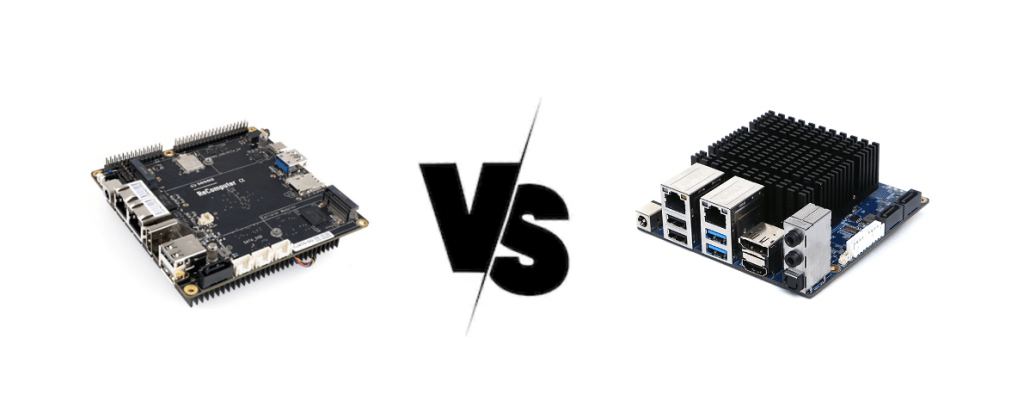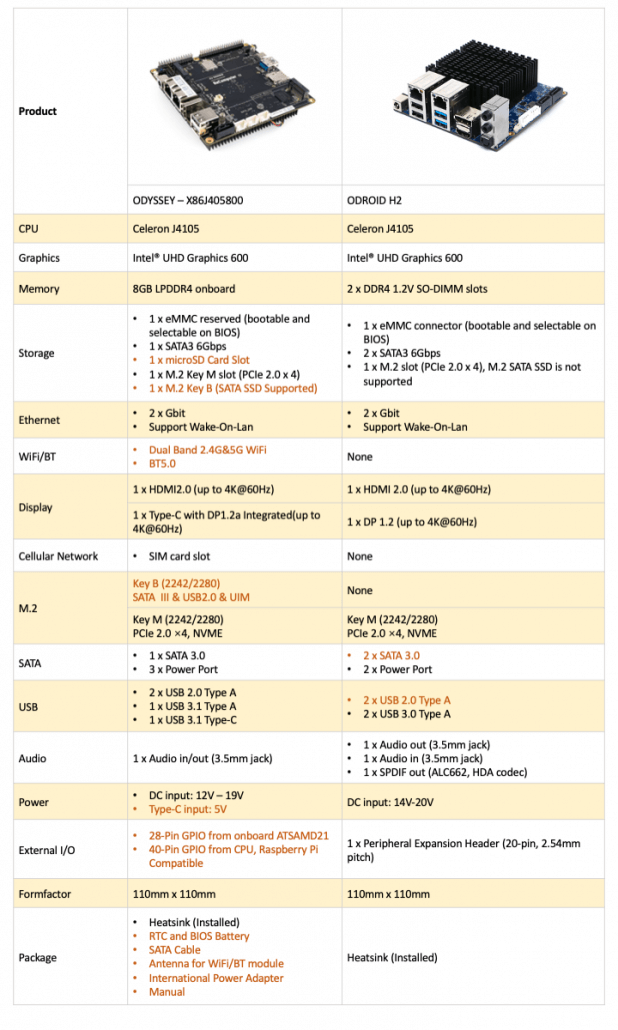ODYSSEY – X86J405 and ODRIOD H2 Comparison

Ever since the ODYSSEY – X86J405 mini PC was released, we have been hearing from the community that the ODROID H2 is quite similar to the ODYSSEY – X86J405. They are both based on Intel Celeron J4105, both have dual Gigabit Ethernet, even the form factor are both 110m x 110m. While they are so similar, there are still many differences between them.
In order to explain, we have made a comparison table and will make a summary regarding the pros and cons of both boards. Since the ODYSSEY – X86J4105 has three versions, here we use the version that is without EMMC, so that it is more similar to the ODROID H2.

Memory
The ODYSSEY – X86J4105 comes with 8GB LPDDR4 RAM onboard. The ODROID H2 does not has onboard RAM, but has 2 slots for adding RAM. It is hard to say which is better, onboard RAM provides convenience, RAM slot provides more flexibility for users who have different scenarios and needs.
Storage
Both boards provide multiple options for external storage. Such as reserved EMMC, M.2 for PCIe SSD, SATA 3.0 interface. While the ODYSSEY – X86J4105 has provided more options like microSD card slot and M.2 Key B for more SATA SSD.
Network
One of the main features for the ODYSSEY – X86J4105 and ODROID H2 is the dual Gigabit ethernet, which makes them very suitable for applications like router and pfSense. Regarding the wireless network, the ODYSSEY – X86 has an onboard WiFi/BT module that supports dual-band wifi and BT5.0. What’s more, it has an onboard SIM card slot, which means by adding an M.2 4G or 5G module, and a SIM card, you are able to build 4G even 5G gateway/router. The wireless network capability is a very big difference between the ODYSSEY – X86J4105 and ODROID H2.
Display
There is nothing much about display because both boards support HDMI2.0 and DP1.2 that are capable of 4K@60Hz display output. The difference is that the ODYSSEY – X86J505 uses a USB Type-C port for the DP display. This is a feature that similar to the latest Macbook Pro. If you like USB Type-C, it would be a great feature for you.
Power
Both boards use DC jack as a power supply. The ODYSSEY – X86J4105 can also USB Type-C as 5V power input. That provides more flexibility to power the board.
External I/O
When it comes to USB, both of them provide 2 x USB 2.0 and 2 x USB3.x. The difference is that the ODYSSEY – X86J4105 makes 1 USB3.1 port as USB Type-C. While the ODROID H2 has 2 USB3.0 port as USB Type-A.
But for GPIO, the ODYSSEY – X86J405 has many more GPIOs than the ODROID H2. The ODYSSEY – X86J4105 has an onboard microcontroller ATSAMD21 that is compatible with Arduino, there are 28-pins are breakout from the microcontroller. In addition, it has an on-board 40-Pin that is compatible with Raspberry Pi. If you are a maker and want to intact with some sensors and actuators with the board, these features are useful.
Package
I didn’t find information for the package of ODROID H2, but it does provide many accessories on the website for you to choose from. For the ODYSSEY – X86J405, the package has included an international power adapter, RTC&BIOS battery, SATA cable, antennas for WiFi/BT module, and a manual.
Summary
From these comparisons, it seems that the ODROID H2 tires to provide a board with very very basic functions and low cost. The ODYSSEY – X86J405 provides a more complete package and more options to interact and create with it. If you have more thoughts and opinions for both of the two boards, where come to discuss with us in the forum.